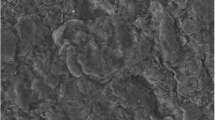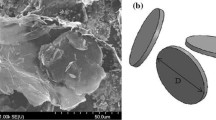Abstract
Ultrasonication is an effective method for dispersing nanoparticles in fabrication of thermoset nanocomposites. Among the various parameters of sonication, the sonication time is the most important one which can directly affect the dispersion of nanoparticles in the matrix. In this study, the effect of sonication time on mechanical properties of the graphene oxide/epoxy nanocomposites is investigated. The nanocomposites were fabricated for 0.05, 0.1, 0.3, 0.5 and 0.7 wt% of graphene oxide (GO). Sonication times of 30–45–60, 40–65–90, 90–120–150, 150–180–210, 210–240–270 min were considered for 0.05, 0.1, 0.3, 0.5 and 0.7 wt% of GO, respectively. Then, the Vickers micro-hardness and compressive response of the samples were examined. The experimental results indicated that the sonication time had considerable effect on the mechanical response of the nanocomposites. For instance, the maximum improvement in yield strength and elastic modulus were 7.55%, 9.83% and were obtained for 0.7 wt% of GO under 270 min of sonication time. The maximum improvement in hardness was 6.83% and was obtained for the sonication time of 120 min for 0.3 wt% of GO. Moreover, a new model was introduced which correlated Vickers micro-hardness of nanocomposites to the compressive properties and the nanofiller weight percentage. The energy transferred during the ultrasonication to the mixture was evaluated and a novel curve was presented for selection of ultrasonication parameters. SEM technique was also used to examine the effect of sonication time on the quality of the nanoparticle dispersion.












Similar content being viewed by others

References
Geim AK, Novoselov KS (2007) The rise of graphene. Nat Mater 6:183–191
Pumera M, Ambrosi A, Bonanni A, Chng ELK, Poh HL (2010) Graphene for electrochemical sensing and biosensing. Trends Anal Chem 29:954–965
Phiri J, Gane P, Maloney TC (2017) General overview of graphene: production, properties and application in polymer composites. Mater Sci Eng B 215:9–28
Zheng Q, Kim J-K (2015) Graphene for transparent conductors: synthesis, properties and applications. Springer, New York
Salom C, Prolongo MG, Toribio A, Martínez Martínez AJ, de Cárcer IA, Prolongo SG (2018) Mechanical properties and adhesive behavior of epoxy–graphene nanocomposites. Int J Adhes Adhes 84:119–125
Alexopoulos ND, Paragkamian Z, Poulin P, Kourkoulis SK (2017) Fracture related mechanical properties of low and high graphene reinforcement of epoxy nanocomposites. Compos Sci Technol 150:194–204
Xue G, Zhang B, Sun M, Zhang X, Li J, Wang L, Song C (2019) Morphology, thermal and mechanical properties of epoxy adhesives containing well-dispersed graphene oxide. Int J Adhes Adhes 88:11–18
Han S, Meng Q, Araby S, Liu T, Demiral M (2019) Mechanical and electrical properties of graphene and carbon nanotube reinforced epoxy adhesives: experimental and numerical analysis. Compos Part A Appl Sci Manuf 120:116–126
Tang L-C, Wan Y-J, Yan D, Pei Y-B, Zhao L, Li Y-B, Wu L-B, Jiang J-X, Lai G-Q (2013) The effect of graphene dispersion on the mechanical properties of graphene/epoxy composites. Carbon 60:16–27
Eqra R, Moghim MH (2016) Effect of strain rate on the fracture behaviour of epoxy–graphene nanocomposite. Bull Mater Sci 39:1197–1204
Shadlou S, Ahmadi-Moghadam B, Taheri F (2014) The effect of strain-rate on the tensile and compressive behavior of graphene reinforced epoxy/nanocomposites. Mater Des 59:439–447
Payandehpeyman J, Majzoobi GH, Bagheri R (2017) Experimental and analytical investigations into the effects of inorganic filler on the polypropylene nanocomposite microhardness. J Thermoplast Compos Mater 30:1484–1502
Bari P, Khan S, Njuguna J, Mishra S (2017) Elaboration of properties of graphene oxide reinforced epoxy nanocomposites. Intern J Plast Technol 21:194–208
Abdullah SI, Ansari MNM (2015) Mechanical properties of graphene oxide (GO)/epoxy composites. House Build Natl Res Cent J 11:151–156
Chatterjee S, Wang JW, Kuo WS, Tai NH, Salzmann C, Li WL, Hollertz R, Nüesch FA, Chu BTT (2012) Mechanical reinforcement and thermal conductivity in expanded graphene nanoplatelets reinforced epoxy composites. Chem Phys Lett 531:6–10
Yadav A, Kumar A, Sharma K, Shukla MK (2019) Investigating the effects of amine functionalized graphene on the mechanical properties of epoxy nanocomposites. Mater Today Proc 11:837–842
Majzoobi GH, Mohammadi J, Pipelzadeh MK, Lahmi S, Hardy SJ (2015) A constitutive model for hardness considering the effects of strain, strain rate and temperature. J Strain Anal Eng Des 50:284–298
Kumar A, Sharma K, Dixit AR (2019) A review of the mechanical and thermal properties of graphene and its hybrid polymer nanocomposites for structural applications. J Mater Sci 54:5992–6026
Voicu SI, Pandele MA, Vasile E, Rughinis R, Crica L, Pilan L, Ionita M (2013) The impact of sonication time through polysulfone–graphene oxide composite films properties. Dig J Nanomater Biostruct 8:1389–1394
Ghaleb ZA, Mariatti M, Ariff ZM (2014) Properties of graphene nanopowder and multi-walled carbon nanotube-filled epoxy thin-film nanocomposites for electronic applications: the effect of sonication time and filler loading. Compos Part A Appl Sci Manuf 58:77–83
Seretis GV, Theodorakopoulos ID, Manolakos DE, Provatidis CG (2018) Effect of sonication on the mechanical response of graphene nanoplatelets/glass fabric/epoxy laminated nanocomposites. Compos Part B Eng 147:33–41
Shokrieh MM, Esmkhani M, Shahverdi HR, Vahedi F (2013) Effect of graphene nanosheets (GNS) and graphite nanoplatelets (GNP) on the mechanical properties of epoxy nanocomposites. Sci Adv Mater 5:260–266
Montazeri A, Montazeri N, Pourshamsian K, Tcharkhtchi A (2011) The effect of sonication time and dispersing medium on the mechanical properties of multiwalled carbon nanotube (MWCNT)/epoxy composite. Int J Polym Anal Charact 16(7):465–476
Gkikas G, Barkoula NM, Paipetis AS (2012) Effect of dispersion conditions on the thermo-mechanical and toughness properties of multi walled carbon nanotubes-reinforced epoxy. Compos Part B Eng 43:2697–2705
Salsabil MR, Prorot A, Casellas M, Dagot C (2009) Pre-treatment of activated sludge: effect of sonication on aerobic and anaerobic digestibility. Chem Eng J 148:327–335
Yao H, Hawkins SA, Sue H-J (2017) Preparation of epoxy nanocomposites containing well-dispersed graphene nanosheets. Compos Sci Technol 146:161–168
Yang S-Y, Lin W-N, Huang Y-L, Tien H-W, Wang J-Y, Ma C-CM, Li S-M, Wang Y-S (2011) Synergetic effects of graphene platelets and carbon nanotubes on the mechanical and thermal properties of epoxy composites. Carbon 49:793–803
Zanjani JSM, Okan BS, Menceloglu YZ, Yildiz M (2016) Nano-engineered design and manufacturing of high-performance epoxy matrix composites with carbon fiber/selectively integrated graphene as multi-scale reinforcements. RSC Adv 6:9495–9506
Kostagiannakopoulou C, Loutas TH, Sotiriadis G, Markou A, Kostopoulos V (2015) On the interlaminar fracture toughness of carbon fiber composites enhanced with graphene nano-species. Compos Sci Technol 118:217–225
Bortz DR, Heras EG, Martin-Gullon I (2012) Impressive fatigue life and fracture toughness improvements in graphene oxide/epoxy composites. Macromolecules 45:238–245
Author information
Authors and Affiliations
Corresponding author
Ethics declarations
Conflict of interest
The authors declare that they have no conflict of interest.
Rights and permissions
About this article
Cite this article
Nejad, S.A., Majzoobi, G.H. & Sabet, S.A.R. Role of sonication time on mechanical properties of graphene oxide/epoxy nanocomposites under quasi-static loading conditions. Iran Polym J 28, 895–908 (2019). https://doi.org/10.1007/s13726-019-00752-0
Received:
Accepted:
Published:
Issue Date:
DOI: https://doi.org/10.1007/s13726-019-00752-0



